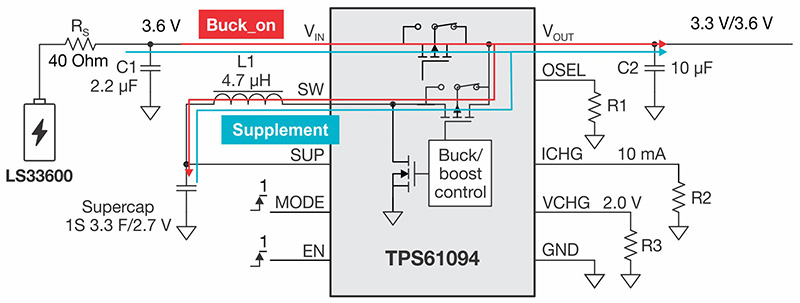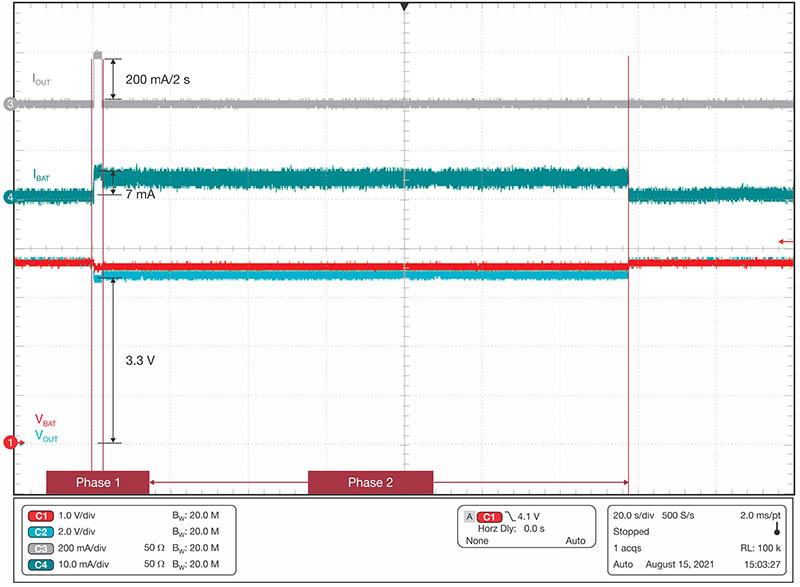SSZT120 November 2021 TPS61094
Lithium thionyl chloride (LiSOCI2) batteries are popular in smart flow meters because they provide higher energy density and a better cost-per-wattage ratio than battery chemistries such as lithium manganese dioxide (LiMnO2). One disadvantage of LiSOCl2 batteries is poor response to peak loads, which can result in a decrease of the usable battery capacity. So in this article, we’ll describe an effective method to decouple peak loads from the battery, in the range of a few hundred milliamperes, that can help increase battery life.
Maximizing the usable battery capacity is important because it enables the system design to support:
- More meter readings and data transmissions from the same battery.
- A longer lifetime from the same battery.
- A smaller battery for the same operating lifetime.
The overall effect minimizes battery and maintenance costs, as well as development costs, by enabling more reuse of a single flow meter design across more kinds of flow meters
| Watch the TPS61094 in action | |
| See how the TPS61094 buck/boost converter maintains ultra-low IQ while integrating supercapacitor charging support in our video "Achieve ultra-low 60-nA IQ with the TPS61094." | |
The Design Challenge: Extend the Battery Life
A successful meter design needs to sustain a long operational time (>15 years) while enabling functionalities such as valve control, data recording and data transmission. Extending battery life is an effective way to increase meter operational time. If you connect the battery to the load directly without any power buffer in between, however, the meter’s complex load profile may deteriorate the battery’s lifetime performance.
Based on the current level, you can divide the load consumption profile of a standard meter into standby mode, middle-stage mode and active mode. Each mode influences battery life differently:
- Standby mode consumes 5 µA to 100 µA. It is mainly quiescent current (IQ) from metrology, microcontroller and protection circuitry. Although the absolute value is very small, it is typically the main contributor to meter lifetimes. In standby mode, the IQ of any connected DC/DC converter should be in the nanoampere range, with the leakage of any power buffer small in order to improve efficiency.
- Middle-stage mode consumes 2 mA to 10 mA. The analog front end in RX stage usually contributes to this load. The power buffer’s efficiency is important to minimize energy loss in this mode.
- Active mode consumes the highest current. In active mode, the load usually comes from the driving valve and analog front end in TX stage, which needs 20 mA to several hundred milliamperes. Directly drawing this current from a LiSOCl2 battery causes severe capacity derating.
Table 1 demonstrates the Saft LS33600 battery’s capacity derating vs. nominal capacity of 17 Ah at different load and temperature conditions. At an operating temperature of +20°C, a 200-mA load current leads to a 42% capacity degradation. Therefore, the battery should never directly supply the load. Only by employing a low-leakage power buffer can you limit the peak current to less than 10 mA.
| Capacity (Ah) | –40°C | –20°C | +20°C |
| 10 mA | –41.2% | –17.6% | No derating |
| 100 mA | –82.35% | –58.8% | –23.5% |
| 200 mA | N/A | N/A | –42.0% |
TI’s 60-nA IQ buck/boost converter, the TPS61094, helps extend battery life while maintaining excellent efficiency over standby, middle-stage and active modes. The TPS61094 has three main benefits:
- Ultra-high efficiency in a wide load range. The TPS61094 has >90% average efficiency for loads from 5 µA to 250 mA under conditions of VOUT = 3.3 V and VIN >1.5 V. This enables an efficient power supply in most flow-meter use cases.
-
Limits the peak current drawn from the battery. The TPS61094 can limit
its peak input current when it is working in Buck_on mode when charging the
supercapacitor, and also in supplement mode when it is supplying a heavy load on
VOUT with the battery. Figure 1 illustrates the configuration of the TPS61094, while Figure 2 shows the battery’s peak current when there is a 200-mA and
2-s load pulse on VOUT. In phase 1, where the load is heavy, the peak
current is limited to 7 mA. After the load is released in phase 2, the device is
charging the supercapacitor with a 10-mA constant current. When the
supercapacitor voltage charges back to 2.0 V, the device stops charging but
still stays in Buck_on mode.
 Figure 1 Configuration of the
TPS61094
Figure 1 Configuration of the
TPS61094 Figure 2 Oscilloscope Result of
Battery Peak Current at Heavy Load
Figure 2 Oscilloscope Result of
Battery Peak Current at Heavy Load - Unchanged available energy from the supercapacitor over the temperature range. Typically, using hybrid-layer capacitors (HLCs) or electric double-layer capacitors (EDLCs) as power buffers will improve pulse-load capability. The energy stored in these passive components depends on the battery voltage, however. When the temperature decreases, the battery voltage also goes down, which deteriorates the HLC or EDLC’s pulse-load capability and increases the battery’s supply current. The TPS61094 eliminates this issue by keeping the voltage on the supercapacitor stable, regardless of temperature.
The usable energy in the supercapacitor is defined by the capacity of the supercapacitor, the set maximum voltage across the supercapacitor and the undervoltage lockout of the TPS61094. The more usable energy that a supercapacitor has, the longer the operating time with a continuous, heavy load.
Figure 3 shows a power-buffer solution using the TPS61094 or only supercapacitors, respectively. For the TPS61094 solution, the supercapacitor voltage is set to 2 V. By supplying a continuous load, the TPS61094 can draw power from the supercapacitor until 0.6 V. Therefore, it is possible to calculate the available energy on the supercapacitor with Equation 1:

where ŋ is average efficiency of the converter.
In the worst case of –40°C, the TPS61094 has an average efficiency of 92% at 150 mA for an input voltage from 2 V to 0.6 V. Equation 2 shows the calculated result:

 Figure 3 TPS61094 vs. HLC/EDLC
Configuration
Figure 3 TPS61094 vs. HLC/EDLC
ConfigurationFor HLC or EDLC solutions, the available energy changes following the battery voltage. For a 10-mA current at –40°C, the LS33600 voltage reduces to 3 V. Equation 3 calculates the available energy:

Comparing results between Figure 2 and Figure 3, the TPS61094 solution has double the available energy of the HLC and EDLC solutions. This means more energy can be delivered to loads, and lowers the peak current drawn from the battery under extreme conditions. For example, if there is a 200-mA load at 3.3 V to drive a valve, an HLC or EDLC solution can only support the load for 2.8 s. The TPS61094 buck/boost converter with an integrated supercapacitor can support the load for as long as 7.8 s, assuming that the power buffer supplies all of the load.
Conclusion
The complex load-consumption profile of flow meters requires a power buffer to help extend LiSOCl2 battery life. With excellent efficiency over wide operating conditions, the TPS61094 is a good choice to remove lifetime extension challenges. By limiting the peak current drawn from the battery, this buck/boost converter maximizes its capacity and raises the supercapacitor’s available energy, enabling the system to operate longer in low-temperature conditions than an HLC or EDLC solution.
Additional Resources
- Check out the TPS61094 data sheet.
- Read the application note, "The Long-lifetime, cost-competitive solution in smart meters based on TPS61094."
- Read the Analog Design Journal article, "IQ: What It Is, What It Isn’t, and How to Use It."
- Read the article, "5 best practices to extend battery life in flow meters"